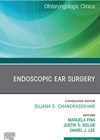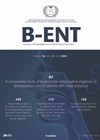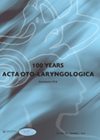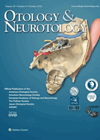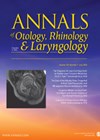
Journal Reviews
Endoscopic stapes surgery - pearls and pitfalls
Endoscopic ear surgery has gained popularity in recent years with wide panoramic visualisation of the operative field one of its key strengths. This article summarises the approach, set-up and outcomes of patients undergoing endoscopic stapes surgery. A key step during...
Dizziness in OSA patients– is there a link and can CPAP treat it?
This is a small study which proposes an interesting hypothesis - that in patients with both dizziness and OSA, treatment of their sleep disorder can provide resolution of their dizziness symptoms, which were otherwise refractory to standard treatment, particularly in...
Virtual reality surgical simulation for the temporal bone
This prospective study looked at 15 otorhinolaryngology residents in Belgium to see if using the VOXEL-MAN Tempo surgical simulator system improved their understanding of temporal bone radiological anatomy. As a secondary aim, they also assessed whether there was any improvement...
3D-printed temporal bone models - how good can they be?
In the era of increasingly difficult and expensive-to-come-by cadaveric temporal bones with which to practise drilling and learn the complex 3D anatomy of the temporal bone, decent alternatives would be welcome. McMillan et al report a prospective comparison study in...
Stepwise approach to manage palatal myoclonus successfully
Palatal myoclonic tinnitus (PMT) is a rare condition caused by rhythmic voluntary or involuntary movements of the soft palate, mainly the tensor veli palatini and levator veli palatine muscles. Patients usually present with a ‘clicky’ noise in the ear. Oral...
Otosclerosis - to scan or not to scan?
In an era of insidiously reducing thresholds for investigating patients, Maxwell and colleagues pose an important question: is high-resolution computed tomography (HRCT) prior to stapes surgery for otosclerosis worthwhile? Their practice typically considers HRCT for cases of suspected otosclerosis presenting...
Satisfaction levels in elderly patients with cochlear implants
Hearing rehabilitation in the elderly is of utmost importance as it is associated with depression and dementia in this age group. Cochlear implantation is indicated for hearing-impaired individuals who do not derive adequate benefit from conventional hearing aids. In this...
Managing hearing preservation expectations of adult CI patients
This paper is a single-centre review of adult cochlear implants in patients with preserved low-frequency hearing, focusing on the outcomes at 10 months post-implantation, and the rates of electroacoustic stimulation actually used in this group of patients. The centre identified...
Facial nerve anatomy in the temporal bone
Knowledge of the facial nerve anatomy during otological surgery is crucial in avoiding an iatrogenic injury to the facial nerve. In this study, the authors investigated the anatomical relationship between the tympanic portion of the facial canal (FC) and the...
Role of imaging in unilateral sensorineural hearing loss
Recent understanding of the significance of unilateral hearing loss in children for language development calls for extensive investigations and early rehabilitation. This retrospective study of 90 children with unilateral hearing loss with high resolution CT scans and MRI revealed that...
Vestibular migraine or BPPV?
There are close similarities between benign paroxysmal positional vertigo (BPPV) and vestibular migraine (VM) as both can be presented by positional nystagmus. Though BPPV remains the commonest cause of pure positional vertigo, VM can mimic this condition. This study is...
A new tool for assessing otoscopy skills
Medical and audiology students need to be proficient in performing otoscopy in order to undertake the routine practice required of them at work upon graduation. One significant challenge in teaching otoscopy is the lack of objective and validated assessment tools...

